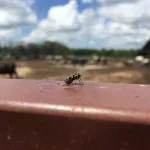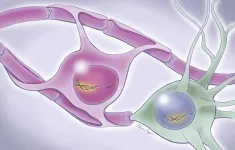(Press-News.org) Social distancing not only helped slow the spread of COVID-19 -- it also may have prevented the transmission of an outbreak of a rare polio-like syndrome, according to Princeton University researchers.
Though uncommon, acute flaccid myelitis (AFM) is a critical spinal condition that causes weakness in the limbs, seriously diminishes motor function, and can lead to lifelong disabilities. The syndrome was first reported in the United States in 2012 and has been coming back every two years, hinting it could strike again in 2020.
Using epidemiological surveillance tools, the researchers showed that an AFM outbreak was likely to occur in 2020, but social distancing prevented its spread.
The reason was that social distancing reduced the occurrence of a respiratory illness known as enterovirus 68 (EV-D68), which the researchers found is strongly associated with AFM. EV-D68 is a virus found in infants and children that typically causes respiratory issues such as a runny nose, cough, or sneezing. While the definite cause of AFM remains inconclusive, it has been linked to viral infections and past studies have specifically identified a link to EV-68.
The Princeton-led research team sought to better understand the connection between AFM and EV-D68 and whether another outbreak might occur. Their findings, published in the journal Science Translational Medicine, suggest that vaccines targeting EV-D68 could lessen future outbreaks of AFM.
"Though currently uncommon, this syndrome has been increasing in frequency with each successive outbreak since 2014, making it critically important to better understand the patterns and drivers behind it," said first author Sang Woo Park, a Ph.D. student in Princeton's Department of Ecology & Evolutionary Biology.
"Our results underline the importance of epidemic surveillance for projecting future impact of infectious diseases," said Bryan Grenfell, the Kathryn Briger and Sarah Fenton Professor of Ecology and Evolutionary Biology and Public Affairs and an associated faculty member in Princeton's High Meadows Environmental Institute.
Grenfell and Park conducted the study with Kevin Messacar of the Children's Hospital at the University of Colorado; Margarita Pons-Salort of Imperial College London; Lindsay Meyers and Camille Cook, former and current employees, respectively, of bioMérieux Inc. or its subsidiaries; and Jeremy Farrar of the Wellcome Trust.
EV-D68 outbreaks have been reported every two years, coinciding with the outbreak pattern of AFM, the researchers said. To confirm this connection, they analyzed patterns of EV-D68 outbreaks using unique surveillance data acquired from BioFire® Syndromic Trends (Trend), a cloud-based network of de-identified pathogen results from around the world collected in near-real time.
The results revealed that EV-D68 outbreaks were occurring every two years in many states, though not all. In states such as Ohio, EV-D68 outbreaks revealed more intricate patterns. Still, the association between EV-D68 and AFM syndrome was strong.
Likely thanks to social distancing, AFM cases remained low in 2020. There were only 31 cases in 2020 compared to 153 cases in 2016 and 238 cases in 2018.
"Fortunately, we saw very little EV-D68 circulation in 2020 and few cases of AFM compared to what was expected, but that makes it even more important to be as prepared as possible for what could be coming in 2021 or beyond," said Park.
INFORMATION:
The paper, "Epidemiological dynamics of enterovirus D68 in the US and implications for acute flaccid myelitis," first appeared online in Science Translational Medicine on March 10. The work was supported by the National Institute of Allergy and Infectious Diseases, the Wellcome Trust, and the Royal Society.
Harnessing a predictive algorithm, Sang Woo Park and colleagues have mapped out new trends in the incidence of the respiratory virus enterovirus D68 in the U.S. since 2014. Their epidemiological study supports research that has linked enterovirus D68 to acute flaccid myelitis (AFM), a rare and mysterious paralyzing disease, and addresses critical gaps in knowledge of how enterovirus D68 has been spreading in the U.S. The analysis also suggests that social distancing interventions during the COVID-19 pandemic likely lowered the prevalence of AFM in 2020. Cases of the polio-like illness AFM, which rapidly results in ...
Adolescents and young adults may be more susceptible to COVID-19 than previously believed, according to analysis of cases in six U.S. states experiencing surges.
INFORMATION:
Article Title: Prevalence of COVID-19 in adolescents and youth compared with older adults in states experiencing surges
Funding: The authors received no specific funding for this work.
Competing Interests: The authors have declared no competing interests exist.
Article URL: https://journals.plos.org/plosone/article?id=10.1371/journal.pone.0242587
...
Individuals' willingness to engage in COVID-19 control measures is associated with their trust in the government, other citizens, and in particular science, according to a new study published this week in the open-access journal PLOS ONE by Stefano Pagliaro of University of Chieti-Pescara, Italy, and colleagues.
The spread of SARS-CoV-2 since December 2019 has posed a severe public health threat to people around the world. As vaccines are being rolled out, behavioral changes are also necessary to counter the spread of the virus. These actions include both prescribed behaviors such as wearing masks, social distancing, and quarantining, as well as discretionary prosocial behaviors like donating to charities ...
New research conducted at the UNESCO World Heritage listed 'Plain of Jars' in Laos has established the stone jars were likely placed in their final resting position from as early as 1240 to 660 BCE.
Sediment samples from beneath stone jars from two of the more than 120 recorded megalithic sites were obtained by a team led Dr Louise Shewan from the University of Melbourne, Associate Professor Dougald O'Reilly from the Australian National University (ANU) and Dr Thonglith Luangkoth from the Lao Department of Heritage.
The samples were analysed using a technique called Optically Stimulated Luminescence (OSL) to determine when sediment grains were ...
A new study, published this week in Proceedings of the National Academy of Sciences, reveals that nitrogen-fixing trees play an underrecognized role in recovering tropical forests by enriching nutrient-poor soils with scarce elements such as phosphorus and molybdenum.
Coauthor Sarah Batterman, a tropical forest ecologist at END ...
In previous research, ancient massacre sites found men who died while pitted in battle or discovered executions of targeted families. At other sites, evidence showed killing of members of a migrant community in conflict with previously established communities, and even murders of those who were part of religious rituals.
But a more recent discovery by a research team -- that includes two University of Wyoming faculty members -- reveals the oldest documented site of an indiscriminate mass killing 6,200 years ago in what is now Potocani, Croatia.
"The DNA, combined with the archaeological and skeletal evidence -- especially that ...
An international research team led by NUST MISIS has developed a new iron-cobalt-nickel nanocomposite with tunable magnetic properties. The nanocomposite could be used to protect money and securities from counterfeiting. The study was published in Nanomaterials.
Presently, research on magnetic nanomaterials with controlled magnetic characteristics is one of the most promising fields. Due to their small size, as well as their excellent magnetic and electric properties these materials have a broad range of potential applications from mobile devices to space technologies.
The new iron-cobalt-nickel nanocomposite was obtained by chemical precipitation, followed by a reduction process.
"This ...
Researchers hope to use an agricultural pest's genetic code against it to prevent billions of dollars in annual losses in the United States.
Stable flies, or Stomoxys calcitrans, are spotted, tan-colored flies found around the world. They are easily mistaken for the common housefly but for one notable distinction: They bite.
"If you get one in your house and it bites you, it's a stable fly," said Joshua Benoit, an assistant professor of biology at the University of Cincinnati.
Stable flies don't bite so much as chomp. They are the scourge of beachgoers in Florida and recreational boaters in upstate New York. According to Thomas Jefferson, they tormented signatories ...
DALLAS - March 10, 2021 - UT Southwestern scientists have identified key genes involved in brain waves that are pivotal for encoding memories. The END ...
Bacteria employ many different strategies to regulate gene expression in response to fluctuating, often stressful, conditions in their environments. One type of regulation involves non-coding RNA molecules called small RNAs (sRNAs), which are found in all domains of life. A new study led by researchers at the University of Illinois describes, for the first time, the impacts of sRNA interactions in individual bacterial cells. Their findings are reported in the journal Nature Communications, with the paper selected as an Editors' highlight article.
Bacterial sRNAs are often involved in regulating stress responses using mechanisms that involve base-pairing ...







